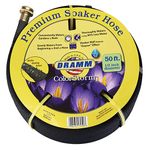
Contemplating the myriad of campanulas makes me feel like a kid in a candy store. The diversity of floral shapes, blossom colors, and plant habits is both astounding and enticing. Every gardener needs at least one campanula (Campanula spp. and cvs., USDA Hardiness Zones 3–9). My fondness for the genus fueled my desire to undertake this trial, and I’m so glad that I scratched that itch. I’ve learned a lot about campanulas over the years, which is not surprising given that we’ve grown well over a hundred different kinds. I’ve seen the good, the bad, and the ugly aspects of the group, but no matter their performance, it’s impossible to deny the fabulousness of their flowers—whatever their shape, size, or color.
Gardeners who covet blue blossoms will be happy to find that campanulas come in a pleasing palette of violet and blue. But if cool tones aren’t your cup of tea, there are pink- and white-blooming options, as well. The flowers put on a show from late spring through summer, often popping up sporadically into early autumn. Campanulas also offer a rich variety of plant habits, from clumpers to rambling spreaders. This means there is a campanula for nearly every spot. Despite all these seemingly good traits, some campanulas are thuggish while others aren’t that troublesome. Culturally speaking, they can range from fickle to surefire to grow. Some have exacting conditional requirements, while others seem to grow anywhere without much fuss. So which ones are dreamy and which ones could be your worst nightmare?
Top performers for your shopping cart
These varieties were chosen as the best because of their good looks, strong habits, and overall hardiness—despite harsh winters and scorching summers.

I can’t say that it was love at first sight, but my appreciation for ‘Sarastro’ campanula (C. ‘Sarastro’) grew at a quick pace. This beauty received the highest rating in our trial for its profusion of violet-blue flowers, compact habit, and winter hardiness. ‘Sarastro’ is one of those campanulas with fantastic tubular flowers dangling in huge clusters above the leaves. The relatively short ‘Sarastro’ isn’t troubled by weak stems, which plague some other cultivars. Its pubescent heart-shaped leaves have more than a passing resemblance to spotted campanula (C. punctata)—it’s one of the parents, after all—but mild-mannered ‘Sarastro’, thankfully, did not inherit the rampant habit. ‘Sarastro’ in full bloom is a beautiful sight, but the faded flowers are anything but pretty. Deadheading removes the brown blossoms and keeps the plant healthy, so don’t forgo that essential chore. I’m a bit dumbfounded that this terrific campanula isn’t better known to gardeners.
In a similar vein, ‘Purple Sensation’ campanula (C. ‘Purple Sensation’) offers an abundance of pendant, dark purple bells beginning in late spring. The 3-inch-long tubular blossoms are lovely, but I find that the color of the nearly black flower buds to be simply luscious. Its compact, bushy habit was slightly larger than ‘Sarastro’ but equally bountiful in bloom. ‘Purple Sensation’ thrives in full sun and is bone hardy in winter.

I know that I’m going to take some flak for including ‘Caroline’ clustered campanula (C. glomerata ‘Caroline’) in the top performers. To be honest, some gardeners look all wild-eyed when I mention it, which makes me a little hesitant to talk it up. It is, indeed, a spreader, but after watching spotted campanula run over its neighbors (becoming nearly impossible to eradicate), I’ve decided that ‘Caroline’ is a lamb by comparison. ‘Caroline’ displays copious pale lavender bells in rounded clusters on stout stems in late spring to early summer The floral show is truly spectacular. Though I was irresistibly drawn to some other clustered-campanula cultivars with darker blooms—I’m a sucker for dark purple—their lax habits were inferior to that of ‘Caroline’, which stayed upright at all times. I recommend shearing the stems back to their base after flowering to keep the plant from self-seeding or looking tatty. I know that its spreading habit will be troublesome for some gardeners, especially those with small gardens or formal borders, but the allure of these pretty blossoms is hard to resist.

Starry Serbian campanula (C. poscharskyana) and its cultivars are wonderful garden perennials, blooming abundantly from late spring to midsummer. All have low, trailing habits, which are ideal for edging walks and borders or tucking into crannied rock walls. Long-blooming ‘Blue Waterfall’ starry Serbian campanula is especially charming for its cheery lavender-blue flowers with pale centers that enhance the star shape. With so many flowers covering the plant, it’s as if each upward-facing blossom is pushing and shoving to be seen above its neighbor. ‘Blue Waterfall’ was one of the largest of the Serbian campanulas—just more to love as far as I’m concerned.

No matter where I see Korean campanula (C. takesimana) growing, it makes me happy. The dramatic profusion of tubular bells dripping from branched stems is stunning. The insides of the creamy white flowers are freckled with red spots, which show through the nearly transparent tubes. While the rich pink flowers of its cousin ‘Elizabeth’ (C. takesimana ‘Elizabeth’) are enticing, I find the species to be satisfying on its own. At a casual glance, the heart-shaped leaves look somewhat like spotted campanula, but upon closer inspection, they are bright green, lustrous, and smooth rather than hairy. I don’t find Korean campanula’s rhizomatous habit to be as fast growing or tenacious as spotted campanula, despite being compared in the same light. Don’t be a shirker where deadheading is concerned because the declining flower stems are particularly unsightly and make the plant look messy. Korean campanula thrives in full sun to light shade and is adaptable to a variety of garden conditions. In my city garden, Korean campanula has migrated from its original location to a shady strip between a fence and the alley—a tough spot, but it loves it there.


‘Samantha’ campanula (C. ‘Samantha’) is such a cutie. The delicate quality of its flower color—light purple–blue paling gradually to white in the center—is accentuated by the upturned, broadly bowl-shaped blossoms that float above the plant in late spring. ‘Samantha’ resembles Carpathian campanula (C. carpatica) in its dwarf mounded habit, but its flowers were more plentiful than any of the Carpathian cultivars and it was more adaptable to moist winter conditions. I was pleased every spring that ‘Samantha’ made it through winter so that I could enjoy its cheerful flowers again.
‘Bernice’ nettle-leaved campanula (C. trachelium ‘Bernice’) is a novelty because of its distinctive double cupped flowers. The violet-blue blossoms crown gently arching leafy stems from late spring to midsummer. ‘Bernice’ is naturally strong stemmed, but rain may collect in the double flowers and pull the stems downward. This is a well-mannered clumper with toothed leaves, which look startlingly like nettles but without the sting. ‘Bernice’ grows best in well-drained soils in full sun to light shade, and is at home in a border or rock garden. I daydream of lush English borders whenever I see ‘Bernice’ in full bloom.
Keep an eye out for these up-and-comers
The following campanulas may not be well known—and some are fairly new to our trial—but their performance, so far, is worthy of mention.

I hesitate calling ‘Viking’ campanula (C. ‘Viking’) a new kid because I’ve evaluated it since 2009, but for many gardeners, it will be a wonderful new discovery. Notably, ‘Viking’ features an abundance of lavender flowers for six solid weeks, beginning in late spring and then on and off well into fall. The 2-inch-long, bell-shaped flowers are clustered at the top and along rigid stems (18 inches tall); interestingly, the flowers face up, out, and down all at once. ‘Viking’ is a meek spreader with rhizomes moving outward at a slow pace. After five years in the ground, ‘Viking’ has spread to 32 inches wide yet still has a compact, neat appearance with no errant shoots. Like most campanulas, ‘Viking’ must be deadheaded; a slew of nasty brown blossoms are the price we pay for the prodigious floral show—but it is so worth it! The flowers draw butterflies and hummingbirds—and, unexpectedly, attracted more than a few sphinx moths last summer.

‘Pink Octopus’ campanula (C. ‘Pink Octopus’) is a campanula with a clearly uncampanula look. The blush-colored flowers are split into narrow petals—like the tentacles of an octopus—and bloom freely from late spring to midsummer and sporadically into fall. Although the overall floral display is not as dramatic to me as other campanulas, there’s a novelty to the spidery blossoms. And I like that the reddish freckles are still noticeable on the insides of the slim petals. The handsome, deeply cut leaves are a treat; their feathery texture is charming and unexpected. ‘Pink Octopus’ is a spreader, to be sure; it reached 12 inches tall and 32 inches wide in three years. That doesn’t seem overly aggressive to me, but I might need a year or two more to judge it fully. We grow ‘Pink Octopus’ in a moist, full-sun garden, but I’ve read numerous accounts of it excelling in dry, shady spots.
Please don’t yell at me but I’m highlighting another clustered campanula: ‘Bellefleur Blue’ clustered campanula (C. glomerata ‘Bellefleur Blue’). Beautiful dark violet–blue flowers graced our plants the first year from late spring into fall. The nearly 1-inch-long bell-shaped flowers were densely clustered at the tips of sturdy stems. Dwarf ‘Bellefleur Blue’ hasn’t, so far, shown its spreading nature—forming dense bushy clumps 13 inches wide the first summer—but I expect it to be 10 inches tall and 24 inches wide at maturity. Just as with other clustered campanulas, you’ll need to deadhead to keep the plant looking tidy. ‘Bellefleur Blue’ was developed for container use but is certainly at home in the perennial garden, too.

Underperforming campanulas
More than 40 campanulas were unable to be rated in the trial because they failed to survive more than two years. Here is a sample of those plants and a brief explanation of what led to their demise.
Campanula ‘Milkshake’ – Weak plants the first year and severe crown loss in winter. Gradually died out the second spring.
C. garganica ‘Dickson’s Gold’ – Three attempts to grow this yellow-leaved cultivar, but sunscald weakened the plants and they died the first winter.
C. punctata ‘Hot Lips’ – Two attempts to grow this plant, but both groups died the first winter.
C. punctata ‘Pantaloons’ – Severe crown dieback the first winter weakened the plants, which were overrun by other C. punctata cultivars.
C. pyramidalis ‘Alba’ – Root rot and winter losses over two years.
C. trachelium – Gradually died over three winters.

The good, the bad, and the ugly
Campanulas are easy-to-grow and trouble-free plants for well-drained, sunny to partially shaded gardens. A little shade in the heat of the day is much appreciated in hot climates. Soggy soils are generally a bad thing for campanulas. Some species, however—such as milky campanula (C. lactiflora), great campanula (C. latifolia), and Korean campanula—prefer moist conditions. For most plants, though, sodden soils cause root rot.

The easiest campanula to grow? Maybe not
We evaluated 21 cultivars of peachleaf campanula (C. persicifolia)—more than any other species—and though widely acclaimed as an easy campanula to grow, it was the least successful group in the trial due to plant losses in summer and winter. Root rot was the most common problem.
There are several reasons to snip the spent blossoms
Deadheading encourages repeat bloom, maintains plant health, and reduces or eliminates seedlings, which can keep the prolific nature of these plants in check.
Poor soil slows down the spreading
It’s no secret that some plants in this genus are thugs. Fast spreaders—such as clustered campanula (pictured), spotted campanula, and rampion campanula (C. rapunculoides* and cvs.)—are best grown in lean soils, where the low fertility curbs their rambunctious nature.

Issues are few and far between
Campanulas are mostly trouble-free, but slugs, rabbits, and foliar rust can cause health and cosmetic concerns for some of them. Although any of these issues can make the plant look unsightly, they usually don’t kill it; the plant will just look ugly for a stint.
Richard Hawke is the plant evaluation manager at the Chicago Botanic Garden in Glencoe, Illinois.
Photos, except where noted: millettephotomedia.com
The following mail-order plant sellers offer many of the campanulas featured:
- Bluestone Perennials, Madison, Ohio; 800-852-5243; bluestoneperennials.com
- Busse Gardens, Big Lake, Minn.; 800-544-3192; bussegardens.com
- Joy Creek Nursery, Scappoose, Ore.; 503-543-7474; joycreek.com
- Phoenix Perennials, Richmond, B.C.; 604-270-4133; phoenixperennials.com
Fine Gardening Recommended Products

Dramm 17050 50′ ColorStorm 1/2″ Standard Soaker Hose

Water Right PSH-100-MG-1PKRS 400 Series, 100-Foot, Olive Green

Gilmour 811673-1001 Sprinkler

















Comments
Log in or create an account to post a comment.
Sign up Log in